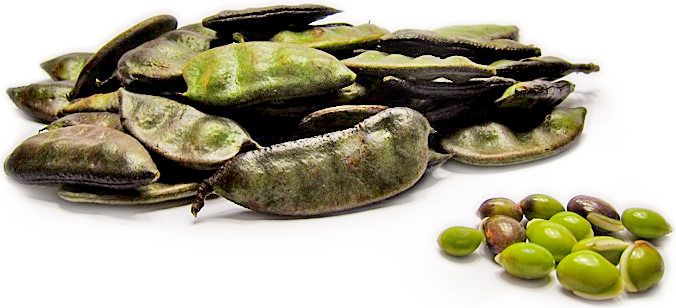


Hyacinth Shelling Beans
Estimated Inventory, lb : 0
Description/Taste
Hyacinth beans are ornamental bean pods that grow on long green trailing vines. When young the pods are deep purple to maroon on their exterior and a bright, vivid green on the inside. Once fully mature, bean pods will turn dark green and the interior beans will take on a darker green hue. When immature the beans are malleable and flattened, like sugar snap peas and once mature the beans double in size and stretch the pods. Immature Hyacinth beans are edible, though they may not taste as good as most other beans. Once mature the beans contain cyanogenic glucosides, antimicrobial agents the plant produces that create a bitter taste and if not cooked properly can be toxic.
Seasons/Availability
Hyacinth beans are available late summer through the early fall months.
Current Facts
Botanically known as Dolichos lablab or Lablab purpureus, Hyacinth beans are also known as Lab Lab, an aboriginal name and Biandou beans. There are a variety of different cultivators grown for different attributes. When superior crops of edible beans are desired highworth from India and rongai from Kenya are grown. Those looking for a bean more so for ornamental purposes than consumption might prefer the ruby moon and white variety which produce longer vibrantly hued beans and more colorful flowers.
Nutritional Value
The Hyacinth beans contains iron, magnesium, zinc, phosphorous, copper and thiamin. The leaves of the Hyacinth beans additionally provide protein and fiber as well as some fat and trace minerals.
Applications
Hyacinth beans have to be very carefully prepared, otherwise they can be poisonous. Most commonly when consumed they are used in their immature state, though they can be eaten when mature as long as they are cooked thoroughly in at least two changes of water. When dry the beans must be soaked twice and again cooked in several changes of water. The mature and dry beans must be cooked in this fashion in order to rid the bean of its toxin, cyanogenic glucoside. Young Hyacinth beans will lose their purple color when cooked, and turn a more modest green. Once properly cooked the beans can be used in a fashion similar to that of conventional shelling beans. They can be added to salads, stir-fries, curries, soups and stews. Cooked beans can also be roasted or fried and served as a snack. To store keep Hyacinth beans refrigerated and use within three or four days.
Ethnic/Cultural Info
In Europe and the United States Hyacinth beans are grown predominately as a decorative vine for their showy blooms and vibrant bean pods. In tropical regions of Asia, Africa and Australia the immature bean pods are eaten raw or cooked and the mature beans are used in cooked preparations. In tropical parts of Asia the beans and flowers are used as a food source and additionally are used to make noodles and are fermented to make tofu similar to soybeans. In India the beans and leaves of the Hyacinth bean vine have long been used as a food source and are popularly added to curries. It is believed that Thomas Jefferson grew the Hyacinth beans at his Monticello estate in Virginia in 1812.
Geography/History
Hyacinth beans are believed to be native to Africa, specifically to the area east of Lake Chad in the East Sundanic Grasslands. Archeological evidence has suggested that the Hyacinth bean from Africa made its way to India between 1600 and 1500 BC where they would become an important food source. Hyacinth beans were first introduced to Europe in the 1700’s as a garden ornamental. Hyacinth beans made their way to America in the nineteenth century where they again were predominately marketed and utilized as an ornamental plant. As a food source Hyacinth beans have long been cultivated in North Africa and Asia. A vining perennial the vines of the Hyacinth bean can reach up to twenty feet in one season and easily grow along trellises and supports, a characteristic which adds to their favor as an ornamental. Plants will thrive in warm to hot growing conditions and are drought tolerant.
Recipe Ideas
Recipes that include Hyacinth Shelling Beans. One
| eCurry |
|
Shorshe Sheem: Hyacinth Beans cooked with Mustard Paste |
| In Good Health |
|
'Bai Bian Dou' Hyacinth Bean Sauce |
| Cooking 4 All Seasons |
|
Pithiki Pappu Kura ~ Hyacinth Bean Curry |




